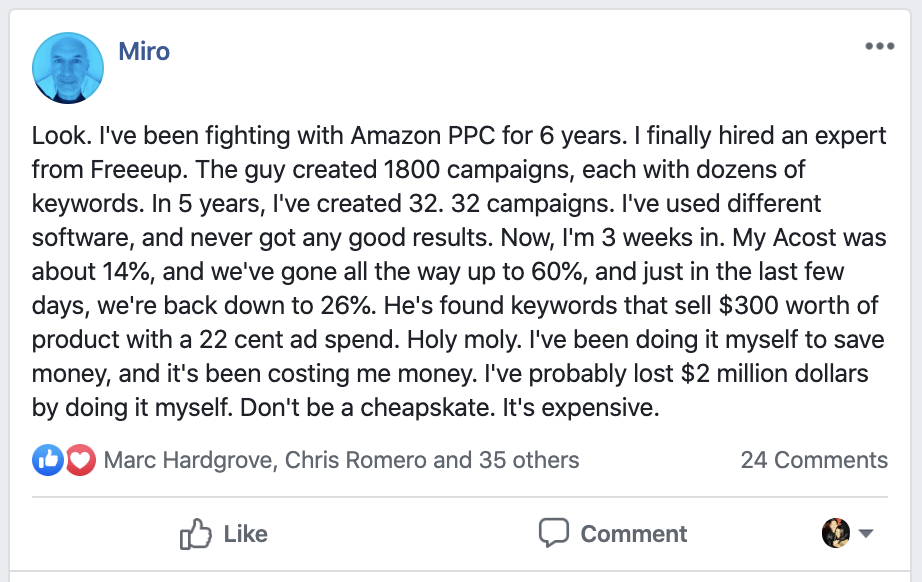

Quick Links
Quick Links
Have you ever bought something cheap trying to save some money, only to have it fall apart and break shortly after?
…Then you had to spend even more money to replace it?
It makes you wish you would have just bought the quality version from the beginning!
You see, the same thing can happen when you try to hire cheap.
Hiring the cheapest sometimes can turn out to be expensive because you have to do the work all over again!
Short-Term Profits vs. Long-Term Profits
Before we get into the hidden costs of hiring cheap, let me explain a bit about how you should think about pricing your hires.
Everybody wants to hire the most economical rate.
In fact, it’s your financial duty as a business owner to maximize profits.
But there is a difference between short-term profits and long-term profits.
You see, if you want to maximize your short term profits, you could just lay off everyone that you have, stop paying your rent, cut out all the quality of your product or service, and massively cut down your expenses. Your monthly profits could skyrocket!
But the problem is that next month, you’ll have no one to help keep your business running, no office, all your customers will come back and want refunds, and it will crumble.
This is an extreme example to make a point: It’s never about the short-term.
Instead, you should always focus on long-term profits.
Sometimes paying MORE now might mean less short-term profits, but more long-term.
Not to mention saving the headaches that hiring cheap will cost you!
So What Should You Pay?
Here’s what you should pay:
You should pay someone what they are worth to you. Not more. Not less.
Now that’s a very subjective statement, but let me explain.
When you pay someone too low, they get resentful and they look for another job. Not good.
When you pay someone too much, they get cocky and stop working as hard.
But if you pay someone what they are worth, then you usually win all around.
Keep in mind, for the right talent, they will gain experience which will increase their value over time, and they can be compensated for that as well.
But how do you determine “what someone is worth?”
Our 3-Level Tiered System For Freelancer Rates
One way to start is to check out our 3 Level system that helps break down freelancer types.
This will help you get a general range, based on what type of work you’re looking to hire:
Entry Level Freelancers ($5 – $10 / hour)
- No special skill required
- They can learn fast and follow your systems
Mid Level Freelancers ($10 – $30 / hour)
- These freelancers have specialized skills or previous experience
- These are executors, but you’ll want to work with them directly to guide them to what you want done
Expert Level Freelancers ($30 – $75+ / hour)
- These freelancers have multiple years of experience
- They can not only execute the task, but can also drive results for you
- They can also fulfill a consulting role to help you create systems
Learn more about our 3 tier system here.
Remember these are general ranges. As you start at the bottom of the range, you’ll experience the bottom tier of that level, and then as you get to the upper range, you’ll be getting the best workers of that level.
Common Issues & Hidden Costs Of Lowballing Applicants
Now when you try to hire outside of these ranges where you can start running into trouble!
Here are some common issues & hidden costs you might run into if you try to undercut the ranges!
Hidden Performance Issues
Let’s say you offer a freelancer a lower rate, and they are out of work at the moment.
The freelancer probably will accept the job. They have bills that need to be paid.
They probably will be happy that their weekly paycheck will be back, but this will be short-lived.
Over time, they may start to resent the job because they know they are being underpaid.
They know what they deserve and their worth.
The freelancer’s performance will suffer. They may go through the motions, but she won’t perform anywhere near what her credentials suggest she should.
Her mentality will be that a lowball pay is worth a lowball performance.
The freelancer will continue her job hunt while they are working for you until they find a position at the rate they are looking for.
Hidden Training Costs
When you hire an unqualified worker, you’re going to need to invest more in training to get them up to speed.
This most likely means your time – which is probably the most valuable in the company.
If you pay for a more qualified worker, with more experience, or better skills, you can dramatically reduce this cost of training.
Hidden Communication Cost
Skills aren’t the only thing you should look for when hiring freelancers.
In fact, having skills without good communication can make a working relationship extremely difficult or even unacceptable.
Good communication skills can make up for a lot.
By making sure the rate is correct, you’ll not only get better-skilled applicants, but you’ll also get talent that knows how to communicate!
Results Cost
This is one of the biggest reasons to hire professionals, especially if your hiring for a skilled position.
It’s not just the execution of the task, it’s the results.
We just had a recent post to our private Outsourcing & Scaling Facebook group that shares this story perfectly:

In this story, Miro hired a talented freelancer at the right price, who was able to execute the ads better than he was. In fact, Miro even says he has “probably lost $2 Million dollars” trying to do it himself!
What you really want is the result right? Not just for the task to be done?
A-Players can do what 10 B-players can do, in the same amount of time.
Hiring at the right level can make a huge difference in the results you get!
The Cost Of Replacement
You spent money recruiting and hiring your freelancer.
You have probably also invested in her somewhat.
When your freelancer finds another job at the price they are looking for (they eventually will), they will quit and you will have to spend the time, energy, and money to fill the position again
You will have to pay a second time to recruit and hire a replacement, and most likely go through the same exercise again.
You will still have to onboard the replacement and hope that he or she sticks around and produces quality work.
Conclusion
There is an age-old saying that holds true time and time again: You get what you pay for.
Asking potential applicants to take a significant pay cut will only cause issues down the road.
But if you stick to the ranges and hire appropriately, you should be well on your way to working successfully with freelancers.
Have more questions about what’s an appropriate range for your next hire?
Book a call with us here and we’d be happy to help!

I agree. I used to be overcautious about every dollar spend on my business, but learned the hard way that it actually helps more to be generous than stingy.
This is all too true. Unfortunately, I found myself at the employee’s end of the lowball stick, so I know how it feels. And it’s not pretty. At all. How was it for me? Let’s just say I was underpaid by a whopping $20,000, so much that my dreams of finally moving out in my late 20s was instantly crushed. That’s how bad it was. Needing a job, I just took it even though I should have walked and saved the hassle and the 5 months of torture that I had to endure before I ultimately got fired. Lesson learned.
Sorry to hear that, Christopher. And unfortunately, it’s a horrible experience that I’m sure a lot of freelancers can relate to.